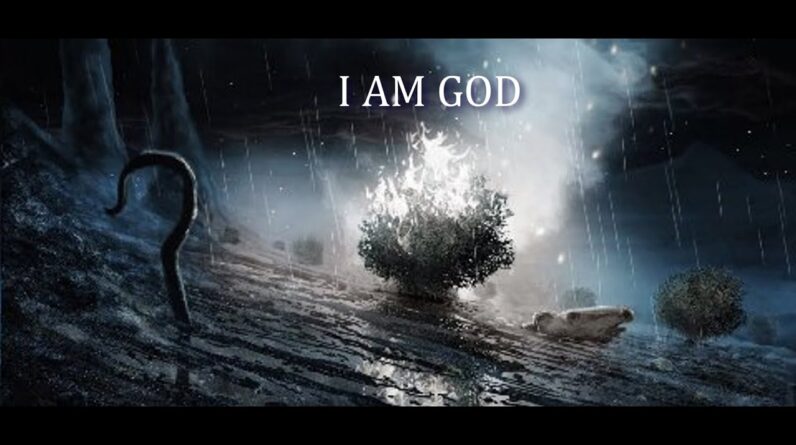In this captivating article titled “Behold, the Lamb of God,” you will find a thought-provoking video that beautifully captures the essence of Jesus’ sacrifice. The video, created by Rietro C and titled “The Passion of the Christ Animation,” is a testament to the love and redemption offered by Jesus Christ. Through breathtaking visuals and powerful storytelling, this animation highlights John 1:29, where John the Baptist proclaims Jesus as the Lamb of God who takes away the sin of the world. Prepare to be moved and inspired as you witness this profound representation of God’s love and salvation.
As you watch the video, you will be immersed in a stirring musical background that enhances the emotional impact of the animation. Rietro C’s creation serves as a powerful reminder of the love and sacrifice of Jesus, inviting you to share this message of love and hope with the world. So, get ready to experience the immense power of “The Passion of the Christ Animation” and be reminded of the enduring truth that the Lamb of God offers salvation to all who believe.
Introduction
Welcome to this comprehensive article on the significance of the Lamb of God in Christianity. The phrase “Lamb of God” is a powerful and evocative metaphor used in the Bible to describe Jesus Christ. Throughout the Scriptures, we find numerous references to the Lamb of God, each highlighting its unique symbolism and importance in Christian theology. In this article, we will explore the biblical references, the significance of the Lamb of God, its portrayal in the Old Testament, Jesus as the Lamb of God, its place in Christian theology, its role in worship, its influence on popular culture, and some controversies and misinterpretations surrounding it. By the end of this article, you will have a deeper understanding of the Lamb of God and its profound impact on the Christian faith.
1. Biblical Reference to the Lamb of God
1.1 John 1:29
One of the most well-known and significant references to the Lamb of God is found in the Gospel of John, specifically in John 1:29. In this verse, John the Baptist sees Jesus approaching and proclaims, “Behold, the Lamb of God who takes away the sin of the world!” This declaration highlights the central role of Jesus as the sacrificial Lamb who would bear the burden of humanity’s sins and offer redemption to all who believe in him. This reference sets the stage for further exploration of the Lamb’s significance in Christian theology.
2. The Significance of the Lamb of God
2.1 Symbolism of the Lamb
The lamb has long been a powerful symbol in various cultures, representing innocence, purity, and submission. In the context of Christianity, the Lamb of God embodies these qualities and more. As the perfect and unblemished Lamb, Jesus represents humanity’s hope for salvation and restoration. His innocence contrasts sharply with the sinful nature of humanity, making him the ideal sacrifice to reconcile mankind with God.
2.2 Sacrificial Atonement
The Lamb of God signifies the concept of sacrificial atonement, which is central to Christian theology. In the Old Testament, the Israelites offered animal sacrifices to atone for their sins temporarily, but these sacrifices were a foreshadowing of the ultimate sacrifice of Jesus Christ. Through his sacrificial death on the cross, Jesus made atonement for the sins of humanity once and for all. His bloodshed on our behalf signifies the depth of God’s love and his willingness to reconcile us to himself.
2.3 Redemption of Sin
The Lamb of God also symbolizes the redemption of sin. By willingly offering himself as a sacrifice, Jesus provides the means for humanity to be freed from the bondage of sin and receive forgiveness. His sacrifice offers the opportunity for every person to have a renewed relationship with God, unburdened by guilt and shame. The Lamb’s sacrifice becomes the ultimate act of love and grace, offering salvation to all who believe in him.
2.4 Universal Forgiveness
The Lamb of God’s significance extends beyond individual salvation to the concept of universal forgiveness. Jesus’ sacrifice is not limited to a select few but has the power to extend to all people throughout history. Through his death and resurrection, Jesus offers the hope of eternal life and reconciliation with God for everyone, regardless of their background, ethnicity, or social status. This universal forgiveness is a testament to the all-encompassing love of God and the transformative power of the Lamb’s sacrifice.
3. Old Testament Foreshadowing
3.1 Passover Lamb
To truly appreciate the significance of the Lamb of God, it is essential to understand its roots in the Old Testament. One significant foreshadowing of the Lamb of God can be found in the Passover story. In Exodus, the Israelites were instructed to sacrifice a lamb and spread its blood on their doorposts as a sign for the angel of death to “pass over” their homes. This act of sacrifice and the subsequent deliverance of the Israelites from slavery in Egypt foreshadowed the ultimate deliverance that Jesus would bring through his sacrificial death.
3.2 Isaiah’s Suffering Servant
Another foreshadowing of the Lamb of God is found in Isaiah’s prophecy of the Suffering Servant. In Isaiah 53, the description of a servant who would suffer unjustly and bear the sins of others aligns closely with the sacrificial and redemptive role of Jesus as the Lamb of God. This prophetic vision underscores the divine plan of God’s salvation through Jesus, emphasizing the Lamb’s willingness to bear the weight of humanity’s sins.
4. Jesus as the Lamb of God
4.1 Jesus’ Sinlessness
One of the defining characteristics of the Lamb of God is Jesus’ sinlessness. In the New Testament, Jesus is repeatedly referred to as the spotless Lamb who was without sin. This sinlessness makes him the perfect sacrifice and demonstrates his complete obedience to God the Father. Jesus’ purity and righteousness stand in stark contrast to the fallen nature of humanity, highlighting his role as the perfect Lamb who takes away our sins.
4.2 Jesus’ Sacrificial Death
At the heart of the Lamb of God symbolism lies Jesus’ sacrificial death on the cross. Like the sacrificial lambs of the Old Testament, Jesus willingly laid down his life for the sake of humanity. His death was not a tragic accident but a deliberate act of love intended to provide reconciliation between God and humanity. Through his sacrifice, Jesus bore the punishment that humanity deserved, allowing us to be forgiven and restored to a right relationship with God.
4.3 Jesus’ Resurrection
The Lamb of God’s significance is not solely confined to Jesus’ sacrificial death but also encompasses his resurrection. Jesus’ resurrection from the dead signifies his victory over sin and death, offering hope and eternal life to all who believe in him. By conquering death, Jesus validates his sacrificial act, demonstrating his power as the Lamb of God who has the authority to save and bring about new life. The resurrection completes the redemptive work of the Lamb and solidifies his role as the Savior of all.
5. The Lamb of God in Christian Theology
5.1 Substitutionary Atonement
The Lamb of God plays a pivotal role in Christian theology through the concept of substitutionary atonement. This theological framework posits that, through his sacrificial death, Jesus took upon himself the punishment that humanity deserved for their sins. By offering himself as a substitute, Jesus paid the price for sin on behalf of humanity and provided the opportunity for forgiveness and salvation. The Lamb’s sacrifice becomes the ultimate act of love and grace, offering reconciliation between God and humanity.
5.2 Jesus as the Passover Lamb
The imagery of the Lamb of God is closely tied to the Passover narrative in Christian theology. Just as the Israelites were delivered from the bondage of slavery in Egypt through the blood of the Passover lamb, so too are believers delivered from the bondage of sin through the blood of Jesus, the Lamb of God. Jesus’ sacrifice is seen as the ultimate fulfillment of the Passover, providing salvation and freedom for all who trust in him.
5.3 Jesus’ Victorious Sacrifice
The Lamb of God is also celebrated for his victorious sacrifice in Christian theology. Through his death and resurrection, Jesus triumphed over sin, death, and the powers of darkness. This victory represents not only the Lamb’s power and authority but also provides believers with hope and assurance. The Lamb’s sacrifice becomes the foundation for Christian faith, reminding believers that they serve a victorious Savior who has conquered all evil and offers eternal life.
6. The Lamb of God in Christian Worship
6.1 Songs and Hymns
The Lamb of God has long been a central theme in Christian worship. The rich imagery surrounding the Lamb has inspired countless songs and hymns that express adoration, gratitude, and praise. These musical expressions provide believers with a means to reflect on the Lamb of God’s significance and deepen their worship experience. Whether sung corporately or privately, these songs and hymns serve as a reminder of the Lamb’s sacrificial love and the salvation that he offers to all who believe.
6.2 Communion and the Eucharist
The Lamb of God is intrinsically linked to the sacrament of communion or the Eucharist in Christian worship. During this sacred rite, believers partake in the body and blood of Christ symbolized by bread and wine. This act of communion represents the believer’s participation in the sacrificial death and atoning work of the Lamb. By partaking in communion, believers remember and proclaim the Lamb’s sacrifice, strengthening their faith and fostering a deeper connection with God.
6.3 Symbolism in Christian Art
The visual representation of the Lamb of God in Christian art has been a powerful medium for depicting its significance. Artworks depicting Jesus as the Lamb often emphasize his meekness, innocence, and sacrificial nature. From stained glass windows to paintings and sculptures, these artistic representations serve as visual reminders of the Lamb’s redemptive work and inspire contemplation and reverence. Symbolism in Christian art helps believers connect with the Lamb’s sacrifice on a visceral and emotional level, deepening their appreciation for its significance.
7. The Lamb of God in Popular Culture
7.1 Portrayal in Films and Media
The Lamb of God’s profound significance has not been limited to religious contexts but has also found its way into popular culture. Throughout the history of cinema and media, Jesus as the Lamb of God has been portrayed in various films and animations. From “The Passion of the Christ” to animated depictions of the biblical narratives, these portrayals aim to convey Jesus’ sacrificial nature and his ability to bring about redemption and forgiveness. Although their accuracy may vary, these portrayals have played a role in introducing and reinforcing the Lamb of God’s narrative to a wider audience.
7.2 Influence on Literature and Poetry
Beyond visual media, the Lamb of God has also left its imprint on literature and poetry. Poets and writers have drawn inspiration from the Lamb’s symbolism to convey themes of redemption, forgiveness, and the transformative power of sacrifice. From traditional religious texts to contemporary works of fiction, the Lamb’s image and its associated themes have resonated with audiences across cultures and generations, underscoring its universal appeal and enduring impact on human imagination.
8. Controversies and Misinterpretations
8.1 Misunderstanding of Lamb Imagery
Despite the widespread acceptance and profound meaning attached to the Lamb of God, there have been instances of misunderstandings and misinterpretations of its imagery. Some have erroneously associated the Lamb solely with weakness and passivity, overlooking its sacrificial and redemptive significance. It is essential to understand the complex symbolism and theological depth underpinning the Lamb of God to avoid reducing it to a simplistic or one-dimensional representation.
8.2 Debates on Atonement Theories
The Lamb of God has also been at the center of theological debates concerning various atonement theories. Different Christian traditions have offered different interpretations of how Jesus’ sacrificial death brings about forgiveness and reconciliation. While many embrace the concept of substitutionary atonement, others hold to alternative theories such as the moral influence theory or the ransom theory. These debates demonstrate the ongoing theological discussion surrounding the Lamb of God’s significance and its profound impact on Christian theology.
Conclusion
In conclusion, the Lamb of God stands as a central and profound metaphor in Christian theology. From its biblical references and Old Testament foreshadowing to Jesus’ sacrificial death and subsequent resurrection, the Lamb’s significance cannot be overstated. It embodies symbolism, sacrificial atonement, redemption, and universal forgiveness. Its portrayal in Christian worship, popular culture, and the impact it has had on literature and poetry further reinforces its overwhelming influence. Despite controversies and misinterpretations, the Lamb of God remains an enduring symbol of hope, love, and salvation, inviting all to partake in the transformative power of its sacrifice. May the Lamb of God continue to inspire and unite believers in their faith journey.








